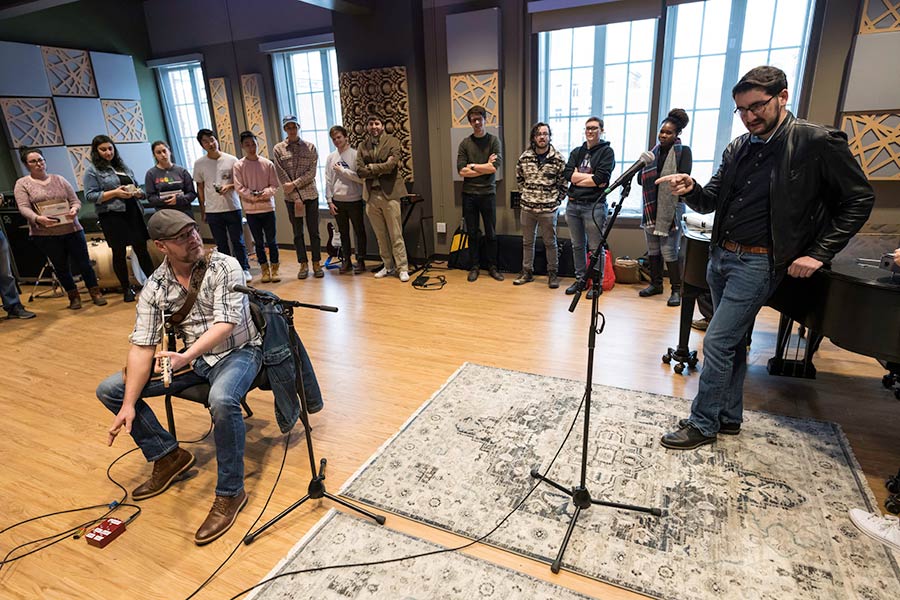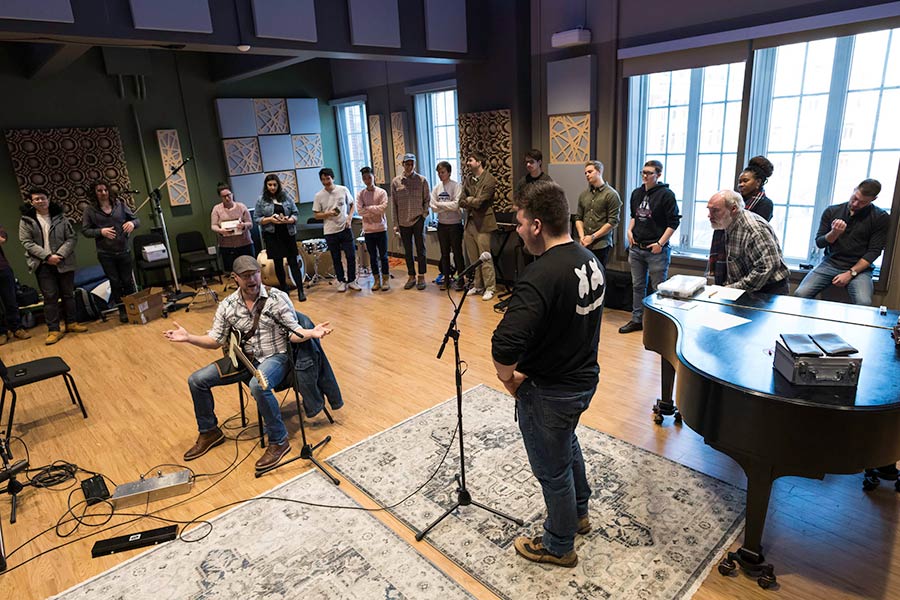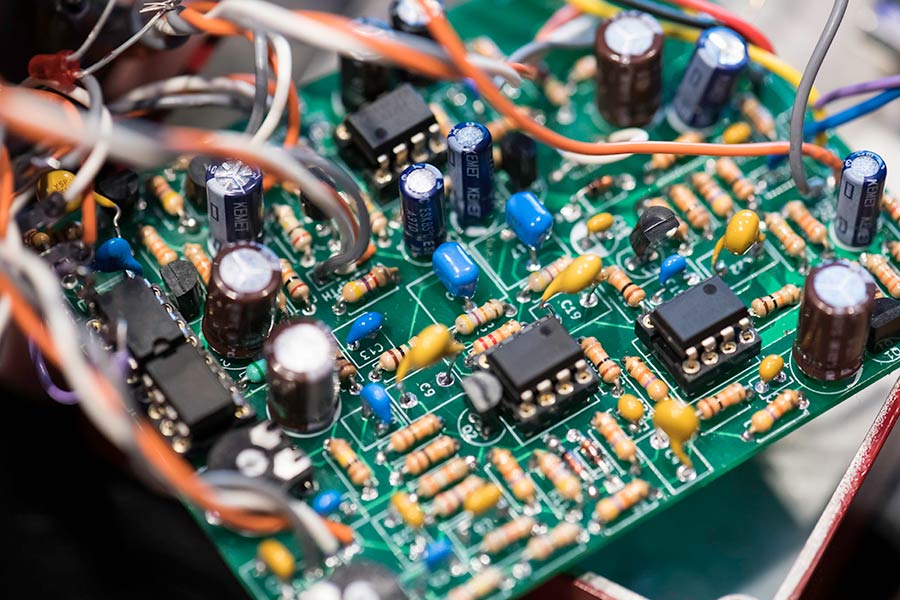Student-made guitar pedals pass muster with a pro

Bryan Price leans forward, turning the knobs on a spring reverb pedal with one hand, while strumming his Telecaster guitar with the other.
The sounds that emerge from the amplifiers in the new recording studio at Gavett Hall have an almost ethereal quality.
Price, a professional musician, is duly impressed.
“You have a wide sweeping range of reverb, which is extremely cool,” Price tells Greg Hernandez ’20. Hernandez, a University of Rochester audio and music engineering major, designed and built the spring reverb for AME 295 – an audio electronics portfolio class. The two dozen students in the class this semester used skills acquired from three previous analogue design classes to custom design their own guitar pedals, then personally assemble and package the electronic circuitry.
The challenge: Create guitar pedals that are not only technically correct, but aesthetically appealing to guitarists who use the pedals to coax different sounds, textures and special effects from their instruments.
“Not for nothing, you put this in a nice little tweet box, then it becomes not just cool, it becomes sexy,” Price tells Hernandez, drawing appreciative laughter from his classmates. “This is really, really sweet. Well done.”
Dan Phinney, the course’s adjunct instructor, is also impressed. He and two other judges place Hernandez’s spring reverb among the top three “best sounding” guitar pedals submitted by students.
“What these students are doing is extremely creative from a musical perspective and there are some very challenging designs from a technical perspective,” says Phinney, a former Kodak electrical engineering manager who does consulting work for Rudak Engineering.
“I am very proud of what I am seeing from these students.”

‘It’s not like any other program’
The audio and music engineering program, launched six years ago at the University of Rochester, is distinctive because it:
- allows students to combine their passion for music with rigorous training in technical and engineering skills
- emphasizes start-to-finish “real-world” projects
- gives students ample opportunities to learn from professional audio engineers and musicians
This enables students to enter—and keep up with—the rapidly changing field of audio and sound engineering. Their skills are needed not only in the recording, film, podcasting, and broadcast industries, but by any companies that incorporate music and sound effects in their product lines. This includes producers of consumer electronics (e.g. cell phones and smart speakers), home entertainment, and video games; manufacturers of professional audio equipment and musical instruments; and computer and Internet companies like Apple, Amazon, Facebook, Google, and Microsoft.
Hernandez became interested in acoustics when he built a loudspeaker in high school. He enrolled in civil engineering at Syracuse University, “built another more advanced loudspeaker out of my own curiosity,” he says, “and knew that I wanted to change my degree and aim more towards audio engineering, physics, and sound.”
He did an online search for music technology programs, found out about the acoustics, physics, and audio signaling processing offered by the program at Rochester, and applied within a week.
“I absolutely love it,” Hernandez says. “It is not like any other engineering program I looked at. It is very heavily project based. It’s interdisciplinary, combining a lot of mechanical engineering, physics, and electrical engineering with musical performance and recording. You can become a producer, a recording engineering, an acoustic engineer, a physicist – anything focused on sound.”
“Truthfully, it has changed the whole path of what I wanted to do,” Hernandez says. He has had an opportunity to do research with Mark Bocko, the chair and professor of electrical and computer engineering who spearheaded the AME program. And an internship as an acoustic hardware engineer at Apple this past summer “proved to me that I wanted to continue my education because I wanted to do more and have an even bigger impact than I already did,” Hernandez says.
He now plans to pursue a PhD in acoustics or mechanical/electrical engineering.

Passionate and engaged
Phinney says he is impressed by the passion and dedication of the students he works with in the class, which he has taught for two years. They are in the labs at all hours working on their projects, he says.
Adam Meltzer ’20 estimates he spent 16 hours just on soldering, then another 10 hours troubleshooting and re-soldering his flanger guitar pedal. Total time on the project? “About 100, maybe 120 hours,” Meltzer says. “I wanted to make something that sounded really cool, and I really enjoy the (AME) program, so that was a good reason to really pour some time into this.”
His flanger was technically one of the most complicated projects. A flanger basically duplicates the input signal and then plays the signals back slightly out of phase and with a slight delay, creating a unique sound. Unlike most commercially available flanger pedals, Meltzer designed his with “true bypass.”
Price conceded he doesn’t often use a flanger, but had positive comments for Meltzer. “You’ve got a lot of really, really cool stuff here, and you’ve got a lot of control.”
That was helpful, Meltzer says. “It lets me know I’ve done a good job of providing the user a way to take varied approaches with my pedal.
“Also, he has a different perspective from me,” says Meltzer, who played tuba for 12 different ensembles while in high school. “I’m not a professional musician, and I don’t play guitar, so it was nice to get an idea of what a guitar player is looking for.”
Meltzer plans to complete a master’s degree in electrical engineering at Rochester through the GEAR program, then do software work for an advanced electronics company “ideally but not necessarily related to audio.” But definitely “something innovative,” he says.
Eventually he may pursue a PhD “if I can come up with something innovative enough,” Meltzer adds. “Maybe start a company, get patents on a few things, and be an inventor. Why not?”
Phinney says finds the “level of passion of AME students toward their future careers to be extremely high. Believe me, they are engaged, and a lot of fun to work with.”
